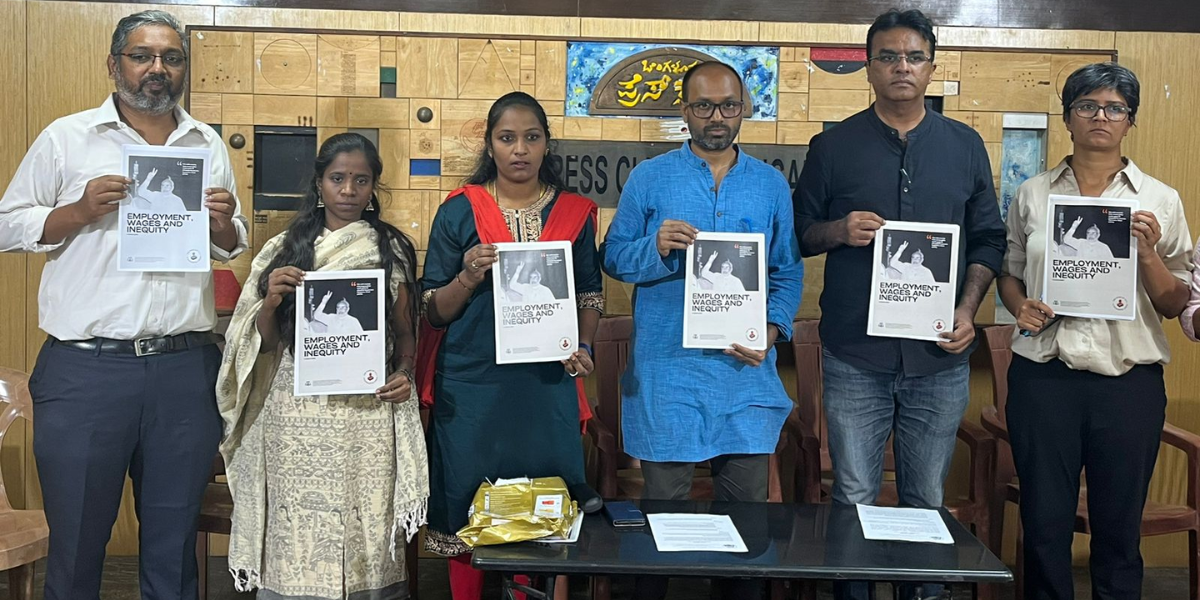In 2012, the bottom 50 percent held 6.1 percent of the income, which further reduced to 5.6 percent in 2022.

Civil Rights activists and advocates collective release Report Card on Employment, Wages & Inequality in the country. (Supplied)
Punching holes in the NDA government’s claim of Sab Ka Saath, Sab Ka Vikas, a study found gross inequality in the country with just 10 percent of the population holding 64.5 percent share of the total income, while the earnings of others dipped.
The study, Employment, Wages, and Inequality, by Bahutva Karnataka, noted that the 10 percent held 63 percent of the total income share in 2012.
Bahutva Karnataka, a collective of civil rights activists, advocates, and organisations, however, said its findings were not about any particular political formation. It crosschecked promises made in manifestos over the past decade with ground reality.
“This is not about blaming the BJP, Congress, or any other political party or outfits for its agenda or how it ran the government. It is about holding the elected representatives accountable for the claims and promises made in their manifestos. The study is based on government data,” researcher Professor Rajendran Narayanan told South First.
The study checked the government’s claims made over the past 10 years and the reality. The data on employment and wages in the report were from the publicly available Periodic Labour Force Survey (PLFS), the now-discontinued Employment-Unemployment Survey, and the World Inequality Database, representing 49 crore workers in the country.
“Sab Ka Saath Sab ka Vikas, in reality, translated to 63 percent of the national income being held by the top 10 percent in 2012. This has been increased to 64.5 percent in 2022,” Advocate Vinay Sreenivasa told South First.
“However, in 2012, the bottom 50 percent held 6.1 percent of the income, which further reduced to 5.6 percent in 2022. The rich grew richer and the poor, poorer,” he added.
Bahutva Karnataka released report cards on the performance of various sectors ahead of the 10 May Assembly polls in Karnataka.
The report said around 42 percent of graduates aged below 25 were unemployed. The percentage of self-employed people increased between 2011-12 and 2022-23. More than half of the men and more than two-thirds of the women were now self-employed.
Stagnant household earnings among the poor forced more women to take up housekeeping jobs without pay or assist the menfolk in the family in their shops. Many women took up salary-less housekeeping jobs to escape starvation and to stay alive, the report said.
One out of three women from poor households were now working without pay. Five years ago, it was one out of four.
The latest finding contradicted the NDA government’s claim that around two crore new jobs would be created every year. The alliance’s 2019 manifesto stated that the government would encourage industries and corporations to generate better employment opportunities for women.
On wages, the NDA manifesto claimed a 42 percent growth in the National Minimum Wage over the preceding five years. “We will maintain the same direction over the next five years to ensure a respectable living for the workers,” it promised.
However, the study said the wages stagnated across all main categories of employment, regular wage, self-employed and casual labour. An expert committee on wages, constituted by the Ministry of Labour and Employment, said in 2019 that the national minimum floor wages in India should be at least ₹375 a day, which should be taken to ₹508 per day by 2022-23.
Bahutva Karnataka found that nearly 30 crore workers have been earning less than the threshold amount of ₹375 recommended by the committee headed by Anoop Satapathy.
Nine out of 10 casual-wage workers, three out of five self-employed, and half of regular-wage workers were earning less than the threshold wage, and more than one in three households’ income, too, was less than the recommended minimum amount, the report stated.
“A comparison of the government’s claims with the actual data reveals that the graph is moving in the wrong direction,” Sreenivasa said.
“From this year’s Budget, the allocations are moving towards the opposite direction. The Budget allocations for five major social sector schemes (NREGA, NSAP, Mid-Day Meals, ICDS, and PMMVY) has only been 0.40 percent of the GDP,” he pointed out.
(Edited by Majnu Babu)

Jul 27, 2024

Jul 26, 2024

Jul 26, 2024

Jul 26, 2024

Jul 26, 2024

Jul 26, 2024